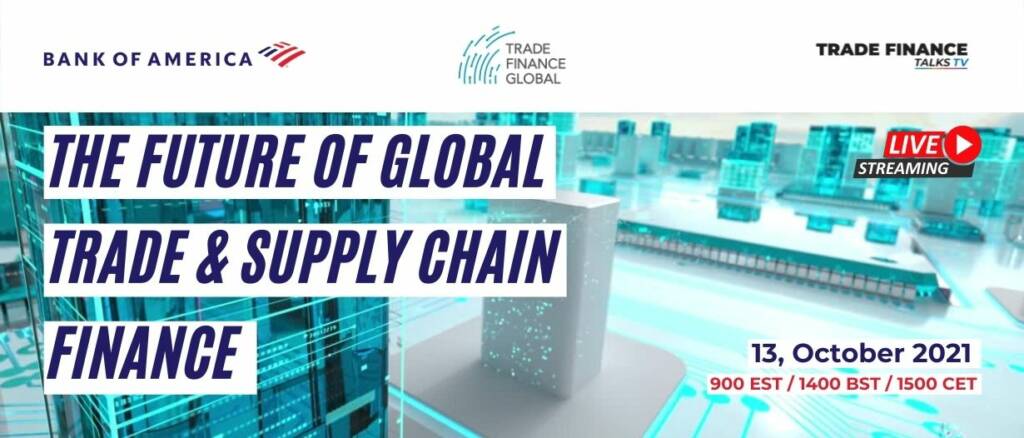Our editor, Deepesh Patel (DP) sat down with Geoff Brady (GB), Head of Global Trade & Supply Chain Finance, Bank of America, Madhav Goparaju (MG), Head of Digital Transformation – Trade and Supply Chain Finance, Bank of America and Chris Doroszczyk (CD), Head of Strategy & Business Development – Cloud, IBM to discuss the impact of COVID-19, access to finance and technology.
The impact of COVID-19 on global value chains
DP: What are your views on shipping companies and customs that still used paper throughout the pandemic?
MG: For digitisation and the ecosystem of shipping companies and customs, COVID-19 will accelerate digital adoption, with the aid of local governments and regulatory agencies. It will continue to need to be a hybrid of digitisation and all digital solutions. Digital transformation will continue to get accelerated.
GB: It’s a great question, and I think illustrates why the ecosystem is what is important. A drive to paperless, digitalisation, etc., isn’t going to fully succeed unless it is accessible for all relevant parties. We’re only going to be as digital as the most analogue part of the process, and if logistics providers, shippers, and ports aren’t included in the overall efforts, we’re not going to invoke positive change.
DP: What are your views regarding the security of digital transport documents and how they can affect trade finance operations in future?
MG: Historically, the challenge for transport documents (e.g. Bills of Lading) has always been either at the beginning of the shipping process or at the end of the delivery process for three-way matching. Where fintechs etc. can help, is to track goods and provide real-time, in-transit data that helps strengthen the financial decision-making process for banks.
GB: Greater adoption will tell the story, but I think we can see how this can and will be useful, as transport documents today still tend towards paper, and, as such, constitute their share of the friction in the process. Again, this is why logistics providers, shippers, and ports need to have a seat at the digitalisation table.

Access to finance
DP: The world is currently experiencing supply chain crises that are deeply affecting African trade, and this is happening despite the waning of the pandemic. What are trade professionals doing to ensure sustainability in African trade?
GB: Africa has been a particular focus for the World Bank and other multilateral organisations, as well as export credit agencies for many of the developed companies. That said, we saw that the Asia Development Bank just estimated the global trade finance gap to have increased to $1.7 trillion – a good portion of which is undoubtedly attributable to Africa. Clearly, there is more work to be done here.
DP: Will real-time, business-to-business (B2B) payments change the way treasurers think about optimising working capital, i.e. the classic way of delaying paying accounts payable (AP) and speeding up collecting accounts receivable (AR)?
GB: The goal would be optimising economic value, wherein there might be both delayed payments on one side, and the acceleration of receivables on the other, in such a way that these two things, facilitated by something like supply chain finance or reverse factoring, will create more economic value than existed in the original transaction. In a digital environment, the concept of “float” might be less impactful.
MG: B2B, real-time payments will help accelerate the push for driving digital, end-to-end optimisation of the procure to pay/order to cash cycles. If the upfront process is very paper-intensive, it will slow the various use cases that could be adopted. Also, the use case adoption continues to be fragmented by region and by industry, etc. This will definitely bring supply chain digitisation and real-time payments closer together

DP: Where does Supply Chain Finance stand in Asia?
MG: The need for supply chain financing (SCF) in Asia will only accelerate. With it going deeper into the financing chain, it has become more urgent than before to strengthen the entire chain.
GB: SCF has always provided an important source of liquidity on the supplier side, particularly for suppliers to large global importers. The recent shift we have seen has been much greater adoption on the buyer side. Asian multi-nationals are implementing SCF in ever greater numbers, especially as working capital optimisation proved so important over the last 18 months. The challenge to more widespread adoption will be the lack of standardisation across Asia, with each jurisdiction requiring its own specificity.
Technology
DP: What key policy changes are needed for banking systems to address capital and liquidity vulnerabilities, and also encourage faster digital implementation?
MG: Title documents which can be produced in digital formats need uniform acceptance in many jurisdictions. This is often a legal problem and can be sped up by making relevant policy changes.
GB: Interesting. Those are two different things, but not necessarily mutually exclusive. What you hope is that the capital and liquidity policies, which typically relate to a bank’s balance sheet, don’t conflict with what might facilitate greater adoption of digitisation standards that will allow for faster implementation. Some of this you can control, and some of it you can’t. We’ve already made strides during the pandemic with things like e-signatures, etc., so we have cleared some paths, but the mission will be global standards that will accommodate this digitisation.
DP: Will interoperability and connectivity among players lower the risk of the banks vis-à-vis the borrowers, thanks to data availability and hence fees?
MG: It absolutely will, given that a wide variety of ecosystem players drive the data decisioning. To strengthen and enhance the risk-based decisioning, interoperability of digital data makes that more transparent and effective, and should have a positive impact both for our customers to drive financing to where it is needed, plus economics from the banks’ perspective, as the decisions are now based on digital data rather than pieces of paper.
GB: Time will tell. Data security will certainly be a part of this evolution, and this is where the implied security of blockchain is promising.
Future view
DP: Looking at the next step of digitalisation, and as receivables have more liquidity and visibility for the ecosystem, is there a trend to create a sort of auction around receivables, to bring more value to them and to reduce the commissioning that has been taken by financial institutions?
GB: A great outcome for the market would be accessing and including as much of the potential investor base as possible. There is a sizable global trade finance gap, but there is also a deep pool of investors, bank market, capital markets, etc., that are looking to invest in trade finance. This is where the visibility and liquidity of a marketplace would be impactful.
DP: How does the climate change movement impact certain industries in the supply chain market?
GB: I think we’ve seen a greater focus on environmental – the “E” in ESG – and sustainable supply chains, and I think we’ve seen this across industries. Corporations want to diversify their supply chains, and they want to ensure – to the extent that they can – that their supply chains reflect the values of the corporation when it comes to sustainability. Not just for themselves, but also their buyers and suppliers. This has challenged the banks and providers to keep pace, in order to help them facilitate their supply chain goals.





























